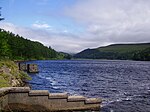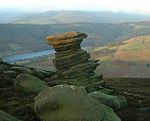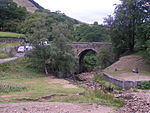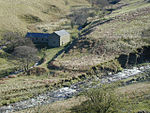River Westend
Derwent (Derbyshire) catchmentEngland river stubsRivers and valleys of the Peak DistrictRivers of DerbyshireUse British English from September 2017

The River Westend flows through the Dark Peak of the Derbyshire Peak District in England. Its source is at Bleaklow Stones on Bleaklow, from where it flows south east into a western arm of the Howden Reservoir. Its lower reaches run through a forestry plantation. Tributaries of the river include Ravens Clough, Black Clough, Fagney Clough, Green Clough and Grinah Grain.
Excerpt from the Wikipedia article River Westend (License: CC BY-SA 3.0, Authors, Images).River Westend
High Peak Hope Woodlands
Geographical coordinates (GPS) Address Nearby Places Show on map
Geographical coordinates (GPS)
| Latitude | Longitude |
|---|---|
| N 53.4312 ° | E -1.74467 ° |
Address
S33 0BB High Peak, Hope Woodlands
England, United Kingdom
Open on Google Maps











